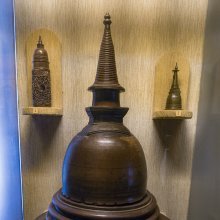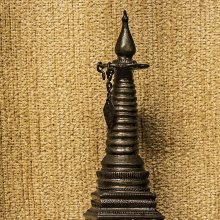Karandu, Karaṇḍu: 3 definitions
Introduction:
Karandu means something in Buddhism, Pali, Hinduism, Sanskrit, the history of ancient India. If you want to know the exact meaning, history, etymology or English translation of this term then check out the descriptions on this page. Add your comment or reference to a book if you want to contribute to this summary article.
Images (photo gallery)
In Hinduism
Purana and Itihasa (epic history)
Source: JatLand: List of Mahabharata people and placesKaraṇḍu (करण्डु) is a name mentioned in the Mahābhārata (cf. I.90.21) and represents one of the many proper names used for people and places. Note: The Mahābhārata (mentioning Karaṇḍu) is a Sanskrit epic poem consisting of 100,000 ślokas (metrical verses) and is over 2000 years old.

The Purana (पुराण, purāṇas) refers to Sanskrit literature preserving ancient India’s vast cultural history, including historical legends, religious ceremonies, various arts and sciences. The eighteen mahapuranas total over 400,000 shlokas (metrical couplets) and date to at least several centuries BCE.
In Buddhism
Theravada (major branch of Buddhism)
Source: Pali Kanon: Pali Proper NamesKing of Dantapura in the Kalinga kingdom. One day in his park he ate mangoes from a tree laden with fruit; his retinue doing likewise, the tree was soon stripped bare. Returning home, the king noticed the state of the tree and compared it with another tree which, having no fruit, was spared such ravages. Reflecting on this topic, he became a Pacceka Buddha and went to the Nandamula pabbhara with three others - Naggaji, Nimi, and Dummukha. The story of these four is given in the Kumbhakara Jataka. J.iii.376ff.
Theravāda is a major branch of Buddhism having the the Pali canon (tipitaka) as their canonical literature, which includes the vinaya-pitaka (monastic rules), the sutta-pitaka (Buddhist sermons) and the abhidhamma-pitaka (philosophy and psychology).
India history and geography
Source: archive.org: Tribes in Ancient IndiaAccording to the Kumbhakāra-jātaka, Karaṇḍu was a Kaliṅga and he was a contemporary of Nimi, king of Videha.

The history of India traces the identification of countries, villages, towns and other regions of India, as well as mythology, zoology, royal dynasties, rulers, tribes, local festivities and traditions and regional languages. Ancient India enjoyed religious freedom and encourages the path of Dharma, a concept common to Buddhism, Hinduism, and Jainism.
See also (Relevant definitions)
Starts with: Karamtu, Karandu-hunu, Karandula.
Ends with: Karamtu.
Full-text: Karamtu, Karakanda, Karandu-hunu, Karandaka, Naggaji, Dantapura, Nimi, Kumbhakara Jataka.
Relevant text
Search found 3 books and stories containing Karandu, Karaṇḍu; (plurals include: Karandus, Karaṇḍus). You can also click to the full overview containing English textual excerpts. Below are direct links for the most relevant articles:
List of Mahabharata people and places (by Laxman Burdak)
The Jataka tales [English], Volume 1-6 (by Robert Chalmers)
Jataka 408: Kumbhakāra-jātaka < [Volume 3]
Theatre Architecture in Ancient India < [October – December, 1998]
Theatre-Architecture in Ancient India < [July-August 1933]



